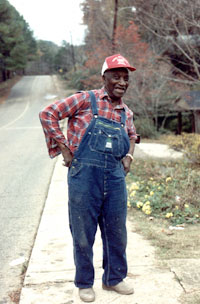Self-Taught Art • Contemporary Folk Art • Outsider Art
Call us at 334.220.5349
[email protected] • Facebook • Instagram • Youtube
Self-Taught Art • Contemporary Folk Art • Outsider Art
Call us at 334.220.5349
[email protected] • Facebook • Instagram • Youtube

Born March 10, 1910, Died September 2, 2007
Cains Ridge, Fayette County, Alabama
One of Sudduth”s earliest memories was of painting a picture at the age of three. The son of an Indian “medicine lady”, he recalled painting with mud and honey mixture on the surface of a freshly cut tree stump while he and his mother were in the woods looking for medicine plants. When they returned days later, the painting was still there. His mother saw this as a good sign and encouraged him thereafter to paint. Finger-painting with mud-earth ochres and “sweet water” became a continual part of his life. He also experimented with adding color to his work by using wild berries, grasses and “paint rocks” in a number of colors and white
Sudduth married an Indian girl at an early age and they had one daughter. After his first wife’s death, Sudduth married Ethel Palmore, his wife of more than thirty years, until her death in 1992. He and Ethel adopted a young boy, Rance Maddov, who was an artist and who later drowned. Sudduth spent most of his life working on rural farms and grinding cornmeal at a grist mill in the Fayette County area. Around 1950 Sudduth moved to the town of Fayette and was an active handyman and gardener for many of the townspeople. He was always eager to make someone a painting and to share a tune on his harmonica quickly becoming a local celebrity.
In 1972 the first public exhibition of his work was organized by Jack Black, Sudduth’s life-long friend, at the Fayette Art Museum. Sudduth was selected as one of two artists to represent Alabama and traveled to the Smithsonian Institution for the Bicentennial Festival of American Folk life in 1976. The Birmingham Museum of Art exhibited his paintings in 1978 and two years later, he was featured on national television on the Today Show.
Sudduth’s work is included in major museums in America today. A one-person show of his work was organized by the Montgomery Museum in 2005 with a book as a catalog called “The Life and Art of Jimmy Lee Sudduth.”
Sudduth lived in a small house near the railroad track with a dog named Toto. He greeted a steady stream of visitors who found their way to him from throughout the world to watch him paint and to hear him wail out the blues on his harmonica. He never learned to read or write but had a funny jingle that helped him “draw” his name on his paintings. He wasn’t concerned with how anyone spelled his name, but If you glimpsed his social security card, there it was spelled “Jimmie Lee Sudduth.” In the last years of his life, he became diabetic and had numerous bouts of pneumonia but never stopped painting until he was placed in a nursing home about six months before he died at the age of 97. He was cared for by his first cousin, Seaborn, and a faithful friend, Dorothy, until then.
When Sudduth was in his early 90’s his old wooden house became condemned. His cousin had a new brick house built up on the hill closer to the railroad tracks behind his old one. He described it as a “palace” and would promptly explain that he had “given it to Dorothy.” Jimmie Lee’s needs were simple. His cousin commented that he was always happy as long as he had a fresh pair of overalls, something to paint on and a harmonica in the key of F.
Sudduth loved to tell everyone, “I’ve been all the way to New York City and my pictures are all over this world!”